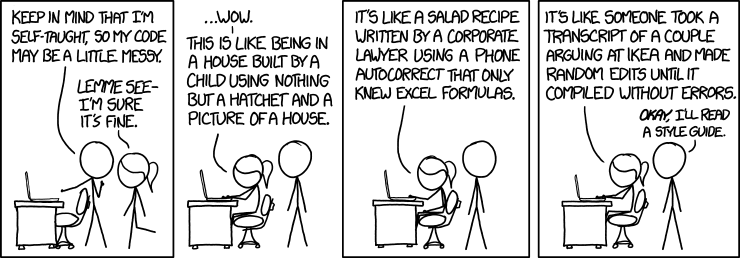Code Styling
Using a consistent and intuitive coding style helps both you as the programmer and others as re-users of your source code. A comprehensive coding style helps to read and understand the code and hence reduces the intrinsic complexity of programming.
Suggested code style for a starter
In the web, there are many definitive coding styles for all sorts of programming language and also they are called definitive, there is generally more than one style. Some to a certain degree consistent opinions you could use to build up your own mind and get a general idea of code styling can be found in an RStudio’s blog entry by Joseph Rickert.
In this course we suggest to follow the style guide by Hadley Wickham published as part of the tydiverse package collection when you write scripts or functions. Note that when it comes to functions, the R community is equally using lowerCamelCaseNames instead of the snake_case_names suggested in the guide.

A note on roxygen documentation and R packages
While documentation is not for the R interpreter but for the user, documentation is mandatory required in R packages. R packages are the things which are installed or loaded if you type install.packages(...) or library(...) respectively. They are a collection of functions and classes written in R and maybe linked to C++ function or other fast running code to speed things up a little. For more information see e.g. Hadley Wickham’s book on R packages.
To streamline the documentation of R package functions and classes, the utilization of the roxygen2 library is the defacto standard. Using this library, the documentation can be written at the top of the respective R file which holds the function or class code. See e.g. the files within the R folder of the mapview package at GitHub. For more information a starting point is again the afore mentioned R packages book.
Please note that roxygen documentation has been developed for R packages but it is a very good idea to follow this syntax also for your individual scripts or functions in order to have a nice and informative header in your scripts.
Suggested documentation header
The following summarizes our suggestion for a documentation header to include in all scripts or functions even when these scripts are not part of an R package.
#' Mandatory: One short line that summarizes for what the script or function is.
#'
#' @description Optional: One to three lines describing a little more about the
#' script or function.
#'
#' @param Mandatory if function: One param at at time.
#'
#' @name Mandatory: Name of the script or function.
#'
#' @export Mandatory if function: Name of the function.
#'
#' @details Optional: Whatever you need to describe regarding the functionality
#' and/or theoretical background of your script or function.
#'
#' @references Optional: If you use something from somebody else, handle it
#' like any other scientific reference/literature list.
#'
#' @examples
#' \dontrun{
#' # Mandatory if part of R package.
#' }
#'
<start here with your R code>
# Header for lager section e.g. read datasets ----------------------------------
<your R code>
# Short comment for a code snipet e.g. a complicated loop
<your R code>